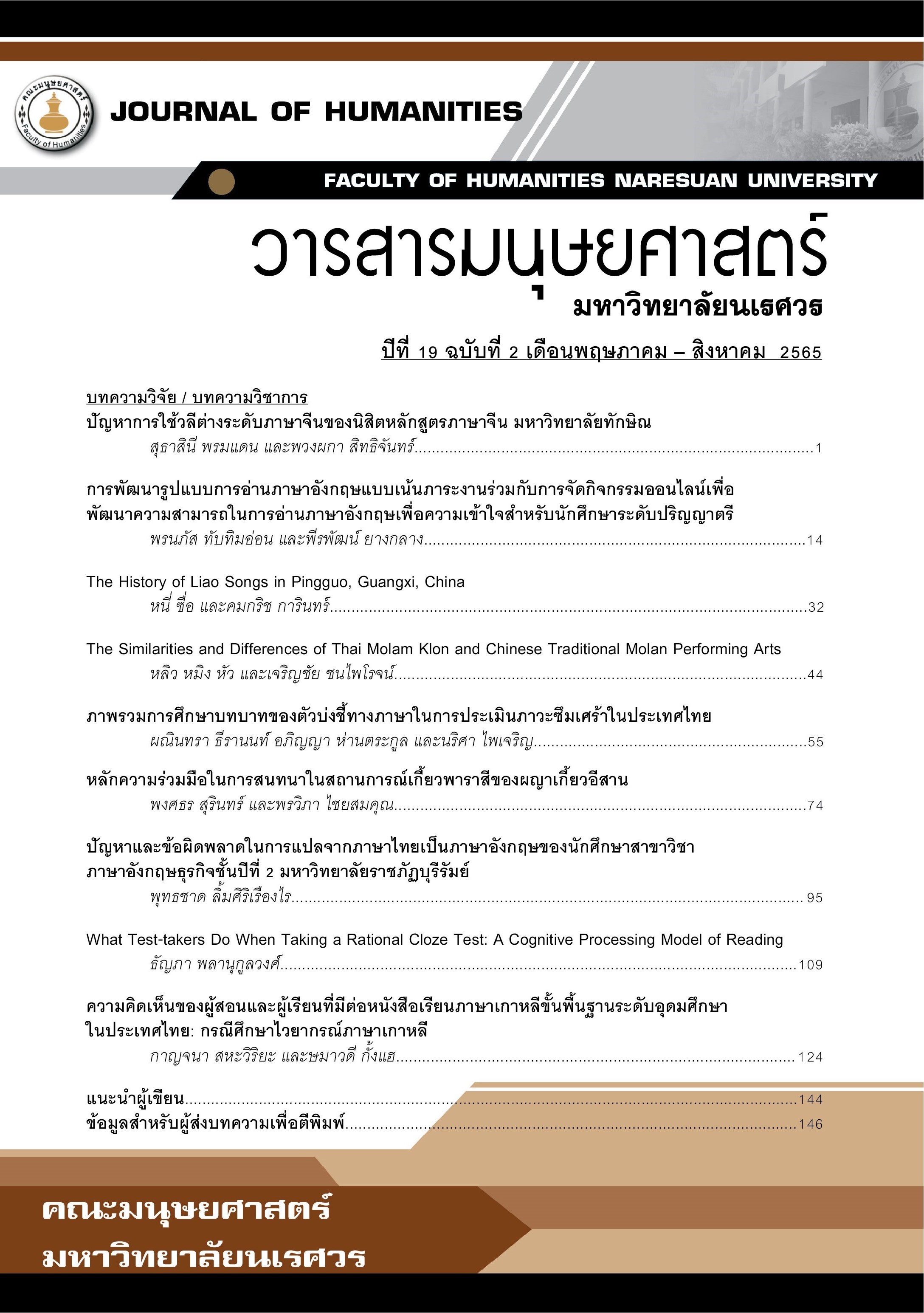ผู้เข้าสอบคิดอย่างไรขณะทำข้อสอบแบบเติมคำ: รูปแบบกระบวนการรู้คิดในการอ่าน
Main Article Content
บทคัดย่อ
ข้อกังวลประการหนึ่งของแบบทดสอบคือแบบทดสอบได้วัดสิ่งที่ต้องการวัดหรือไม่ การวิจัยนี้มีวัตถุประสงค์เพื่อศึกษาความตรงของข้อสอบแบบเติมคำ นักวิจัยใช้ข้อมูลทางวาจาที่เก็บจากการกระตุ้นการเรียกความจำคืนของผู้เข้าสอบที่มีความสามารถทางภาษาสูงจำนวน 16 คน ซึ่งทำข้อสอบแบบเติมคำคู่ขนาน 4 ฉบับเพื่อศึกษากระบวนการคิดที่กลุ่มตัวอย่างใช้ระหว่างทำข้อสอบและวิเคราะห์ข้อมูลตามกรอบแนวคิดของ Khalifa และ Weir (2552) ผลการวิจัยพบว่ากลวิธีที่กลุ่มตัวอย่างใช้บ่อยที่สุดในการทำข้อสอบทั้ง 4 ฉบับ คือการอ่านอย่างพินิจพิจารณาในระดับองค์รวมและระดับประโยค โดยใช้ความรู้ด้านคำศัพท์และไวยากรณ์ ซึ่งแสดงว่าข้อสอบแบบเติมคำวัดความรู้ด้านคำศัพท์และไวยากรณ์ รวมทั้งทักษะการอ่านอย่างพินิจพิจารณาทั้งระดับองค์รวมและระดับประโยค
Article Details

อนุญาตภายใต้เงื่อนไข Creative Commons Attribution-NonCommercial-NoDerivatives 4.0 International License.
ข้อความรู้ใด ๆ ตลอดจนข้อคิดเห็นใด ๆ เป็นของผู้เขียนแต่ละท่านโดยเฉพาะ คณะมนุษยศาสตร์ มหาวิทยาลัยนเรศวร และกองบรรณาธิการวารสารมนุษยศาสตร์ฯ ไม่จำเป็นต้องเห็นพ้องด้วย
เอกสารอ้างอิง
Alderson, J.C. (1979). The cloze procedure and proficiency in English as a foreign language. TESOL Quarterly, 13(2), 219-223.
Alderson, J.C. (2000). Assessing reading. Cambridge: Cambridge University Press.
Anderson, N. J., Bachman, L., Perkins, K. & Cohen, A. (1991). An exploratory study into the construct validity of a reading comprehension test: triangulation of data sources, Language Testing, 8(1), 41-66.
Bachman, L.F. (1985). Performance on the cloze test with fixed-ratio and rational deletions. TESOL Quarterly, 19(3), 535-556.
Bax, S. (2013). The cognitive processing of candidates during reading tests: Evidence from eye-tracking. Language Testing, 30(4), 441-465.
Brunfaut, T. & McCray, G. (2015). Looking into test-takers’ cognitive processing while completing reading tasks: A mixed-method eye-tracking and stimulated recall study. British Council English Language Assessment Research Group.
Gass, S. M. & Mackey, A. (2017). Stimulated recall methodology in applied linguistic and L2 research. New York: Routledge.
Green, A. (1998). Verbal protocol analysis in language testing research: A handbook. In M. Milanovic (Ed.), Studies in Language Testing 5 (pp. 1-175). Cambridge: Cambridge University Press.
Khalifa, H. & Weir, C. J. (2009). Examining reading: Research and practice in assessing second language reading. In M. Milanovic & C.J. Weir (Eds.), Studies in Language Testing 29: Examining reading (pp.1-342). Cambridge: Cambridge University Press.
McCray, G., & Brunfaut, T. (2018). Investigating the construct measured by banked gap-fill items: Evidence from eye-tracking. Language Testing, 35(1), 51–73.
Read, J. (2000). Assessing vocabulary. Cambridge: Cambridge University Press.
Rupp, A. A., Ferne, T., & Choi, H. (2006). How assessing reading comprehension with multiple-choice questions shapes the construct: A cognitive processing perspective. Language Testing, 23(4), 441-474.
Storey, P. (1997). Examining the test-taking process: A cognitive perspective on the discourse cloze test. Language Testing, 14(2), 214-231.
Weir, C. J. (2005). Language testing and validation: An evidence-based approach. Basingstoke: Palgrave Macmillan.
Weir, C. J. (2013). The measurement of reading ability 1913-2012. In M. Milanovic & C.J. Weir (Eds.), Studies in Language Testing 37: Measured constructs (pp.103-256), Cambridge: Cambridge University Press.
Weir, C., Hawkey, R., Green, A., & Devi, S. (2012). The cognitive processes underlying the academic reading as measured by IELTS the academic reading construct as measured by IELTS and the reading experiences of students in their first year of study at a British university. In L. Taylor & C.J. Weir (Eds.), Studies in Language Testing 34: IELTS collected papers (pp.212-269). Cambridge: Cambridge University Press.
Yamashita, J. (2003). Processes of taking a gap-filling test: Comparison of skilled and less skilled EFL readers. Language Testing, 20(3), 267-293.


